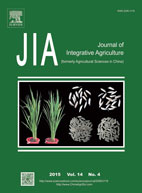|
|
SPEIPM-based research on drought impact on maize yield in North China Plain
MING Bo, GUO Yin-qiao, TAO Hong-bin, LIU Guang-zhou, LI Shao-kun, WANG Pu
2015, 14(4):
660-669.
DOI: 10.1016/S2095-3119(14)60778-4
The calculation method of potential evapotranspiration (PET) was improved by adopting a more reliable PET estimate based on the Penman-Monteith equation into the standardized precipitation evapotranspiration index (SPEI) in this study (SPEIPM). This improvement increased the applicability of SPEI in North China Plain (NCP). The historic meteorological data during 1962–2011 were used to calculate SPEIPM. The detrended yields of maize from Hebei, Henan, Shandong, Beijing, and Tianjin provinces/cities of NCP were obtained by linear sliding average method. Then regression analysis was made to study the relationships between detrended yields and SPEI values. Different time scales were applied, and thus SPEIPM was mentioned as SPEIPMk-j (k=time scale, 1, 2, 3, 4,…, 24 mon; j=month, 1, 2, 3,..., 12), among which SPEIPM3-8 reflected the water condition from June to August, a period of heavy precipitation and vigorous growth of maize in NCP. SPEIPM3-8 was highly correlated with detrended yield in this region, which can effectively evaluate the effect of drought on maize yield. Additionally, this relationship becomes more significant in recent 20 yr. The regression model based on the SPEI series explained 64.8% of the variability of the annual detrended yield in Beijing, 45.2% in Henan, 58.6% in Shandong, and 54.6% in Hebei. Moreover, when SPEIPM3-8 is in the range of –0.6 to 1.1, –0.9 to 0.8 and –0.8 to 2.3, the detrended yield increases in Shandong, Henan and Beijing. The yield increasing range was during normal water condition in Shandong and Henan, where precipitation was abundant. It indicated that the field management matched well with local water condition and thus allowed stable and high yield. Maize yield increase in these two provinces in the future can be realized by further improving water use efficiency and enhancing the stress resistance as well as yield stability. In Hebei and Beijing, the precipitation is less and thus the normal water condition cannot meet the high yield target. Increasing of water input and improving water use efficiency are both strategies for future yield increase. As global climate change became stronger and yield demands increased, the relationship between drought and maize yield became much closer in NCP too. The research of drought monitoring method and strategies for yield increase should be enhanced in the future, so as to provide strong supports for food security and agricultural sustainable development in China. Received 12
|
